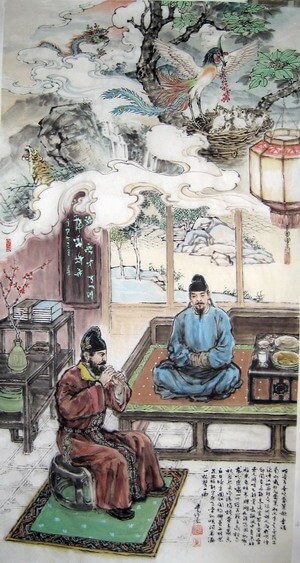On Hearing an Wanshan Play the Reed-pipe
- Poetry of Li Qi

南山截竹为觱篥,此乐本自龟兹出。
流传汉地曲转奇,凉州胡人为我吹。
傍邻闻者多叹息,远客思乡皆泪垂。
世人解听不解赏,长飙风中自来往。
枯桑老柏寒飕飗,九雏鸣凤乱啾啾。
龙吟虎啸一时发,万籁百泉相与秋。
忽然更作渔阳掺,黄云萧条白日暗。
变调如闻杨柳春,上林繁花照眼新。
岁夜高堂列明烛,美酒一杯声一曲。
Bamboo from the southern hills was used to make this pipe.
And its music, that was introduced from Persia first of all,
Has taken on new magic through later use in China.
And now the Tartar from Liangzhou, blowing it for me,
Drawing a sigh from whosoever hears it,
Is bringing to a wanderer's eyes homesick tears....
Many like to listen; but few understand.
To and fro at will there's a long wind flying,
Dry mulberry-trees, old cypresses, trembling in its chill.
There are nine baby phoenixes, outcrying one another;
A dragon and a tiger spring up at the same moment;
Then in a hundred waterfalls ten thousand songs of autumn
Are suddenly changing to The Yuyang Lament;
And when yellow clouds grow thin and the white sun darkens,
They are changing still again to Spring in the Willow Trees.
Like Imperial Garden flowers, brightening the eye with beauty,
Are the high-hall candles we have lighted this cold night,
And with every cup of wine goes another round of music.
Seven-character-ancient-verse
- Why Chinese poems is so special?
- The most distinctive features of Chinese poetry are: concision- many poems are only four lines, and few are much longer than eight; ambiguity- number, tense and parts of speech are often undetermined, creating particularly rich interpretative possibilities; and structure- most poems follow quite strict formal patterns which have beauty in themselves as well as highlighting meaningful contrasts.
- How to read a Chinese poem?
- Like an English poem, but more so. Everything is there for a reason, so try to find that reason. Think about all the possible connotations, and be aware of the different possibilities of number and tense. Look for contrasts: within lines, between the lines of each couplet and between successive couplets. Above all, don't worry about what the poet meant- find your meaning.
List of Chinese poets
Pre-Qin Poetry
Han poetry
Ban Gu Cao Cao Cao Zhi Cao Pi Cai Wenji Kong Rong Liu Bang Liu Che Qin Jia Ruan Ji Su Wu Wang Can Xiang Yu Xu Gan Zhang Heng AnonymousSix Dynasties Poetry
Tao Yuanming Zhang HuaTang poetry
Bai Juyi Bao Junhui Cen Shen Chen Zi'ang Cui Hao Chang Jian Cui Tu Chen Tao Du Fu Du Mu Du Shenyan Dai Shulun Du Xunhe Du Qiuniang Gao Shi Gu Kuang Gao Pian Han Yu He Zhizhang Han Hong Huangfu Ran Han Wo Huang Chao Jia Dao Jiaoran Jin Changzu Li Bai (Li Po) Li He Li Shangyin Liu Yuxi Liu Zongyuan Luo Binwang Li Qi Liu Changqing Lu Lun Li Shen Li Yu Li Qiao Li Yi Liu Fangping Liu Zhongyong Li Ye Meng Haoran Meng Jiao Ma Dai Pei Di Qian Qi Quan Deyu Sikong Shu Song Zhiwen Shen Quanqi Shangguan Wan'er Xuanzong of Tang Wang Bo Wang Changling Wang Wei Wang Zhihuan Wei Yingwu Wen Tingyun Wang Han Wei Zhuang Wang Wan Xue Tao Xu Hun Xu Hui Yuan Zhen Yu Xuanji Yu Shinan Yuan Jie Zhang Jiuling Zhang Ji Zhang Hu Zhang Zhihe Zu Yong Zhang Xu Zhu Qingyu Zheng Tian Zhang Bi Zhang RuoxuSong Poetry
Cai Xiang Chao Chongzhi Fan Chengda Fan Zhongyan Huang Tingjian He Zhu Kou Zhun Jiang Kui Lu You Li Qingzhao Liu Yong Mei Yaochen Ouyang Xiu Pan Lang Qin Guan Qian Weiyan Su Shi Su Zhe Song Qi Wang Anshi Wen Tianxiang Weng Juan Xin Qiji Yang Wanli Yue Fei Yan Jidao Yan Shu Ye Shaoweng Zeng Gong Zhang Xian Zhou Bangyan Zhu Shuzhen Zhu Xi Zhou DunyiYuan poetry
Bai Pu Guan Hanqing Ma Zhiyuan Xu Zaisi Yang WeizhenMing poetry
Chen Jiru Tang Yin Tang Xianzu Xu Wei Yu Qian Yang ShenQing poetry
Cao Xueqin He Shuangqing Nalan Xingde Pu Songling Tsangyang Gyatso Wang Guowei Yuan Mei Zheng Xie Zhao Yi